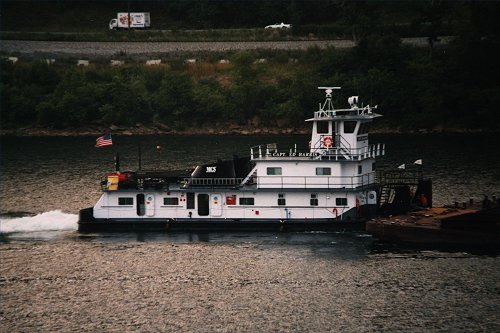Mv. Cahaba at Old Demopolis, Ala. Bridge - April
28, 1979
These photos were posted in a
prominent display at the christening of the Capt. Ed Harris in Buffalo, W.Va. on
June 11, 1999 at the time the Cahaba was given her new name by Madison Coal. Nelson Jones
probably still has the display. At that time it was told that it was common for vessels
for that particular river to release their barges to go under the bridge and then to pick
them up after the towboat had proceeded through the bridge opening. In this particular
case, a face wire failed to unfasten and the boat was dragged under. Her captain stated
that everything came loose except a life preserver. When she resurfaced he started the
engine and managed to catch the tow and proceed to their destination.Shortly afterwards,
the Cahaba was laid up and was dormant until purchased by Madison Coal and re-powered,
refurbished, and renamed.
Dave Massie
Steamship Historical Society
mv/ CAHABA
Built 1972 by Halter Marine, Lockport, LA, 85 x 30, twin GM16V-149 diesels @ 1800hp
Owned by Warrior & Gulf Navigation Co., Chickasaw, Alabama
Click on thumbnails for larger image

The CAHABA now renamed CAPT.ED HARRIS in 1999.
The untold story by Captain Michael L. Smith
The river is the Tombigbee River and this happened to be the record high water ever for that area. The towboat you see coming down on the bridge is the Motor Vessel Cahaba owned by Warrior Gulf Navigation out of Mobile, Alabama. On the return the barges were filled with coal for export at the McDuffie Coal Terminal at the mouth of the Mobile River and at the head of Mobile Bay. The Bridge was the Old Rooster Bridge (since demolished and removed - I saw the explosion to tear it down also) located below Demopolis, Alabama. The land-side highway dead ends at the bluff, and you can still drive to this site and imagine how high the river had to be to get to the bottom of the bridge... The pass or Channel Span of the bridge was located on the far West side of the river, or on the opposite bank from the photographer's standpoint. In normal river flow, we would drop down near the rock bluff and steer through the opening to pass southward with our tows of coal barges.
Normal loads were six barges, each measuring 195' X 35' and loaded to a 10' draft. This allowed each barge to carry approximately 2,000 tons of coal (times six = 12,000 tons X 2000 pounds = 24 Million pounds of cargo.) The boat is 1800 Horsepower twin engine diesel built in Pine Bluff, Arkansas. It is named after one of the eight "friendly" Indian tribes. It is the Motor Vessel Cahaba. At the "sticks" or helm is Captain Jimmie Wilkerson, a long time river pilot and was my personal friend - since deceased. The river current was so very treacherous that we were forced to drop down to the bridge in the slack(er) water on the left descending bank and when we got down to the bridge, we uncoupled the boat from the barges and let the barges drift down under the bridge. The bottom of the bridge would "shave" the coal stacked in the barges off to a level surface. The next step was to back the vessel upriver and then go over to the far West side and traverse the bridge's channel span with the boat, and run down and catch the barges. It was just too dangerous to try to bring the barges through the bridge span in the current.
Anyway, Jimmie dropped down properly and with the entire rest of the crew standing on the barges for safety, he began to reverse his engines to back away. His stern would have to be kept directly pointed into the current or the boat would travel sideways like a kite without it's tail. Captain Jim was a fine pilot, but he made a small mistake and his stern was caught in the current, twisted sideways and the river smashed him into the bridge sideways. Notice that the boat re-surfaced right side up on the down stream side. What luck you say? Nope, WGN ballasted all their vessels with three to four feet of cement in the bottom. The boat was like a little yellow rubber duckie, and came back up like a duckie oughta do. The boat suffered major cosmetic damages, but little flooding because of water tight doors, except in the pilothouse. Notice the picture where the boat is not quite righted and you can see water pouring out of the wheelhouse door. The chair washes out, and Jimmie told me he was holding on to the controls with all his might to keep from going out the drain and into the river. He was very shook up and you can see him approach the tow of barges downriver. Well he didn't get it together quite soon enough and he smashed into the barges, causing further damage.
I next saw Jimmie about a month after this and we had a cup of coffee together and talked about the incident. He was smoking a Camel Non-filter but didn't even need an ashtray because his hands were still shaking too much for the ash to build up to any degree. How do I know all this? I was on the boat that went through the bridge immediately before the Cahaba. The Motor Vessel James E. Philpott made the bridge and was headed south at close to 15 MPH. For all you who don't understand, that is very fast on a commercial towboat with that much tonnage. Glad to pass this on to everybody... Captain Michael L. Smith









